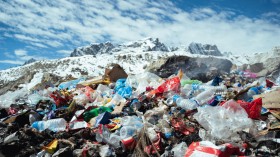The importance of research and planning is being emphasized by two scientists in case the next super eruption poses colossal dangers.
Michael Cassidy, a professor of volcanology from the University of Birmingham, wrote that huge volcanic eruptions, most likely by super volcanoes, are hundreds of times more likely to happen in the coming century than comet and asteroid impacts combined. Cassidy wrote the commentary with Lara Mani, a research associate from the University of Cambridge.
In their commentary, Cassidy and Mani raise the point that while it is wise to be prepared for asteroids, too little is being done to address the likelihood of a volcanic "super-eruption".
They note that hundreds of millions of dollars are spent annually on planetary defense by governments and international organizations, including a recent US experiment to deflect space rocks.
Although they may not be as spectacular as fireballs from space, volcanoes are still worthy of respect because, unlike asteroids, they have already formed on Earth. Volcanoes are found all over the world, often hidden by beautiful landscapes that conceal their destructive potential.
Not Even Close
The majority of the horrific eruptions that modern humans have witnessed pale in comparison to the approximately every 15,000-year eruptions of supervolcanoes.
According to the US Geological Survey, the last super-eruption of this intensity happened roughly 22,000 years ago. An eruption with a magnitude of 8, the highest score on the Volcanic Explosivity Index, is referred to as a "super-eruption."
In 1815, Mount Tambora in Indonesia experienced its most recent magnitude-7 eruption, which is believed to have killed 100,000 people.
The "Year Without a Summer" in 1816 was brought on by the ash and smoke, which on average decreased global temperatures by 1 degree Celsius. Numerous crop failures caused disease outbreaks, famine, and armed conflict.
The two scientists also raised the point that volcano monitoring and the country's capacity to mobilize international assistance for disaster relief have both advanced since 1815, but not necessarily to the extent necessary to balance out all the risks that each country now faces.
Since the early 1800s, the number of people on Earth has quadrupled, and some sizable urban areas have grown up close to active volcanoes, according to Cassidy and Mani.
The two also pointed out that volcanoes could pose a bigger threat than the general public realizes. Based on data from ancient ice cores, scientists found in a 2021 study that the time between catastrophic eruptions is hundreds to thousands of years earlier than previously thought.
Read also: Tonga Volcano Officially the Largest Eruption of the 21st Century, New Data Confirms
Volcano Monitoring
Many volcanoes still have a cloudy past, making it difficult to predict eruptions in the future and concentrate resources where risks are greatest. Cassidy and Mani write that more study is required on ice cores and also geological and historical records, such as marine and lake cores, particularly in regions like Southeast Asia, which are data-poor but high-risk areas.
They continue by pointing out the need for more interdisciplinary research to help predict how a super-eruption might destroy civilization by identifying risks to trade, energy, agriculture, and infrastructure, as well as geographical "pinch points" where volcanic risks collide with vital trade networks.
Additionally, it is essential to conduct more thorough ground-based, aerial, and satellite observations of volcanoes. The scientists point out that volcanologists have long yearned for a specialized volcano-observing satellite, which could improve preparedness beyond the present system of using the same existing satellites with other experts.
Resilience also depends on educating and promoting the community. People must be aware of whether they are in an area at risk from volcanic eruptions, how to get ready, and what to do once one occurs.
In addition to outreach in advance, Cassidy and Mani write that authorities also need ways to inform the public when volcanoes erupt, such as text messages with information about evacuations, survival advice, or directions to the nearest shelters and medical facilities, Science Alert reports.
Related article: Force from Tonga's Eruption Could Have Created Mutliple Tsunamis the Size of the Statue of Liberty
© 2024 NatureWorldNews.com All rights reserved. Do not reproduce without permission.





